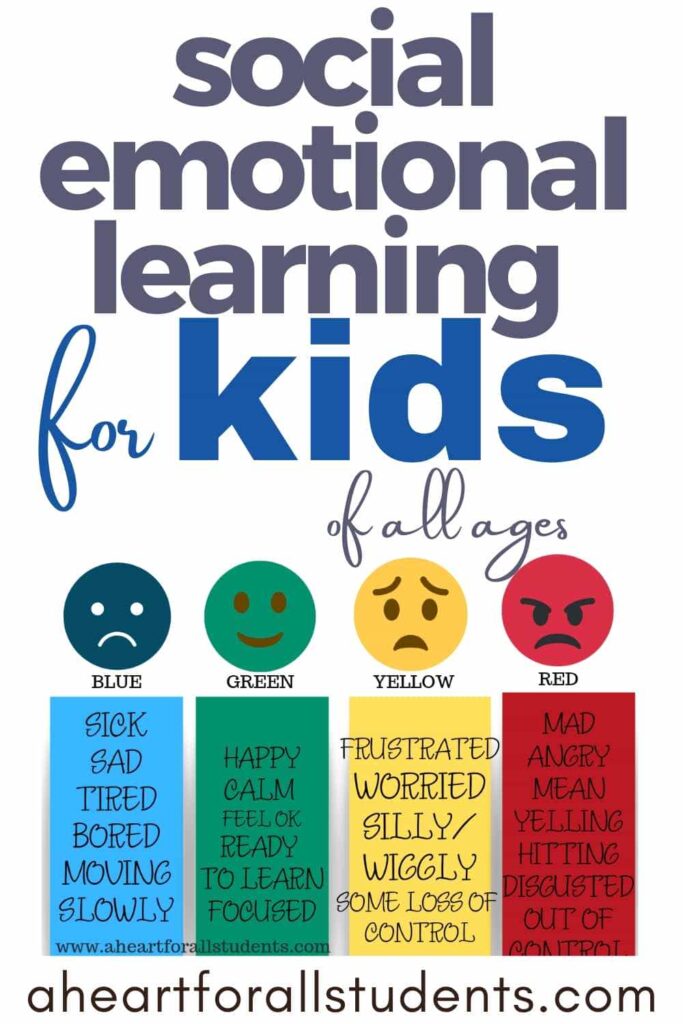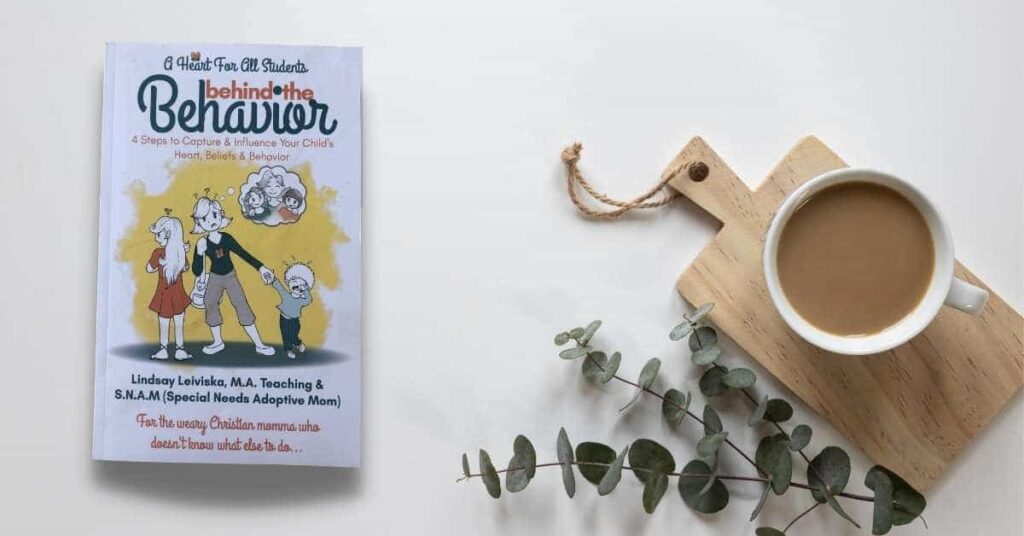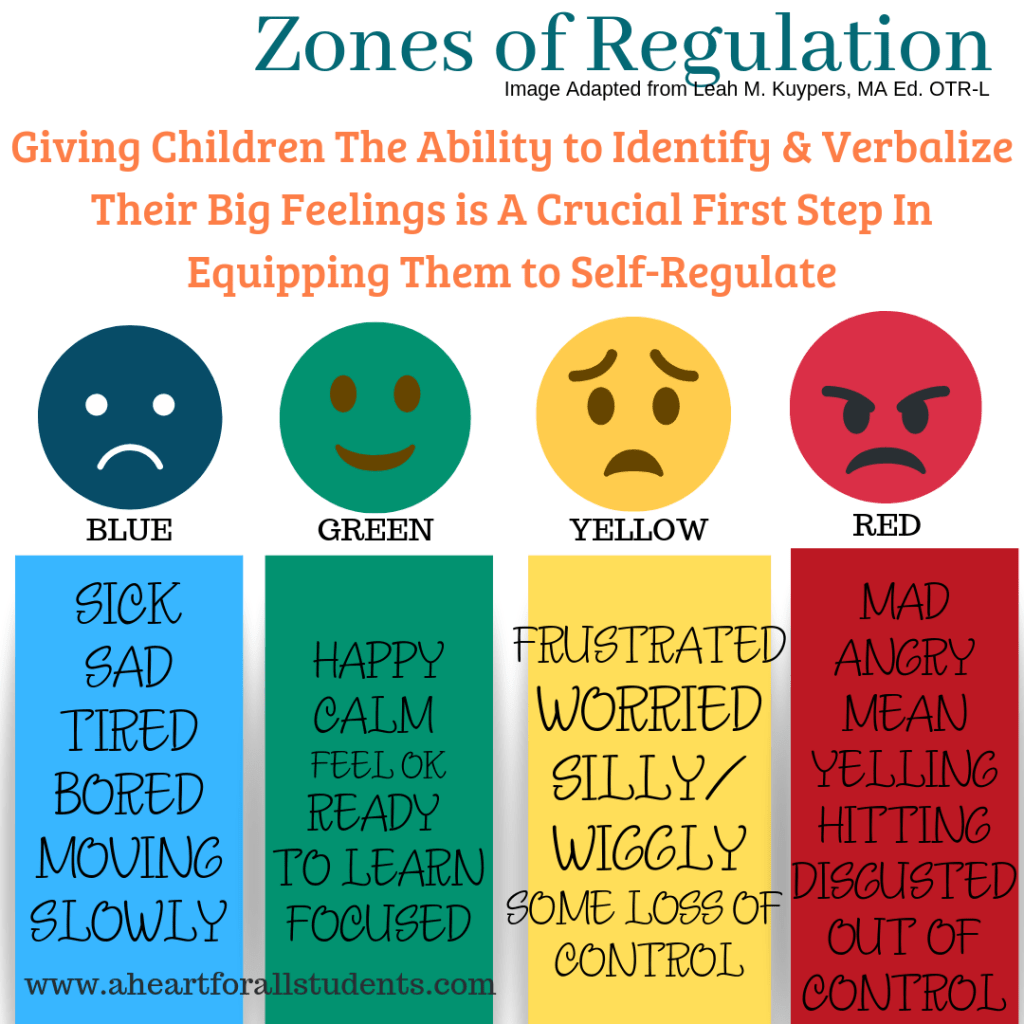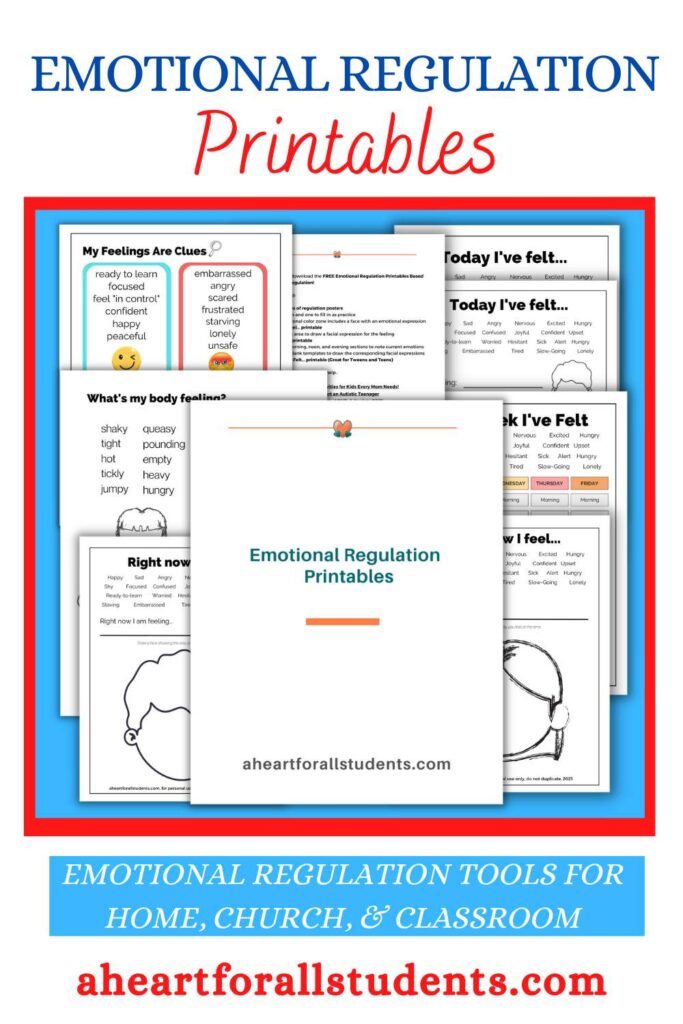How can a tool like the Zones of Regulation help your child’s emotional regulation skills? Perhaps your child loses it at the slightest frustration. Maybe sensory meltdowns are a part of your daily routine. I’ve learned the hard way that if I want to do more than just survive, I’ve got to equip my kids (and myself). So, today, let’s dive into emotional regulation tools like the Zones of Regulation and other visually-based printables.

What Are the Zones of Regulation?
Resources based on the Zones of Regulation are a great teaching tool for kids and adults. The Zones of Regulation curriculum was designed by an occupational therapist, Leah Kuypers, MA. Ed, OTR-L. According to the Zones of Regulation website, the Zones curriculum uses a cognitive behavior therapy approach to help people,
regulate… feelings, energy, and sensory needs… to meet the demands of the situation around us and be successful socially.
The complete program is available on the Social Thinking Company website. However, the chart alone is a great resource to help children identify and communicate different emotions.
Within a Zones of Regulation chart, emotions and physical sensations are categorized into different zones. Each zone is a different color, representing levels of alertness associated with distinct emotional states.
The Zones of Regulation at MY Home
I was originally introduced to the Zones curriculum by my son’s developmental pediatrician. In those earlier visits with her, my son was dysregulated, agitated, and hypervigilant. He was all over the place, and he had horrific sleep problems (he never slept).
To the untrained eye, he appeared to have classic ADHD. (The signs of anxiety in children may look IDENTICAL to ADHD). Because of this (and the horrified, exhausted, desperate look in my eyes), she handed us a lifeline.
- A copy of the Zones of Regulation
Learn More in Behind the Behavior Book!

What I Learned from The Zones of Regulation
When we adults see children struggling with difficult behavior, we must shift our perspective on how we respond. If we only see outward behavior at face value, we don’t solve the actual problem.
Kids (and adults) need to learn their triggers without shame. Then, they need tools to respond in healthy ways.
When a child behaves in a way that appears outwardly disrespectful, adults have to pause and take a deep breath. Then we must step back and think about what may be happening behind the behavior. When we identify root issues, without getting “offended by” kid behavior, we’re able to propel the needle forward.
What Does Each Zone Mean?
In the official Zones of Regulation, there are four zones.
- Green Zone
- Yellow Zone
- Red Zone
- Blue Zone
To get us on the same page, let’s dive into the different zones and what each one means. Remember that each zone is meant to help children identify various emotions as well as their level of alertness. In the end, these zones foster self-regulation and social-emotional learning.
Green Zone
The green zone represents emotional states such as:
- focused
- happy
- content
- confident
- peaceful
- in control
When in the green zone, the level of alertness feels safe.
Yellow Zone
Within the yellow zone, you’ll notice different emotions such as:
- worried
- hungry
- grumpy
- scared
- silly
- confused
- embarrassed
- impatient
These are often associated with high alertness levels.

Red Zone
The red zone is represented by the highest level of arousal or alertness. Specifically, the red zone includes strong feelings such as:
- excited
- hyper
- angry
- scared
- panicked
- frustrated
- starving
- raging
It’s important to note that there is no one ideal zone. Children should never associate strong emotions as bad just because they’re intense. The goal is to help children grow their problem-solving skills and level of emotional control. In the end, this will happen over decades and not in one fell swoop.
Blue Zone
The final zone is the blue zone, which represents a lower level of arousal (alertness). Some of the blue feelings are:
- sleepy
- sad
- bored
- sick
- shy
- needs a break
Again, it’s very important to reiterate that there’s no best state of alertness. In fact, the goal of self-regulation tools is to grow students’ understanding of their internal states of being (interoception).
Benefits of the Zones of Regulation
Tools based on the Zones of Regulation can be very helpful. First, when children can properly identify their feelings, they’re better able to choose different ways of responding to their own needs. Children learn a number of social-emotional life skills that will serve them in the long term.
- self-control
- sensory regulation strategies
- healthy coping strategies
Again, children and adults must understand that no zone is the appropriate zone. No emotional state or alertness level is right or wrong. The goal is NOT to be in the “green zone” at all times.
By practicing mindfulness and an awareness of what’s going on internally, children and adults can offer themselves compassion.
Negatives of Zones of Regulation
One criticism of many social-emotional tools is their focus on neurotypical norms as the best. This has led to the marginalization of neurodivergent children and adults. Autistic children as well as those with ADHD, sensory integration challenges, and many others, have unique ways of experiencing the world.
Neurodivergent people are different, not less. This means when using social-emotional learning tools in a classroom, we must seek the representation of all learners in the whole class.
Unfortunately, Zones of Regulation and Social Thinking Company uses terms that may be harmful to neurodivergent children. For example, when discussing social interactions with peers.
- Unexpected behaviors vs expected behaviors
- Neurodivergent social skills and responses are labeled “unexpected”
- With the message that autistic children need to act in “expected” non-autistic ways
A great way to support all children is to take a more inclusive approach that fosters understanding and compassion.
Inclusive Social-Emotional Learning
This means teaching the majority group (neurotypicals) about the value of minority neurotypes. Some simple ways to do this in a school, children’s ministry, or family include:
- Discussing the unique sensory experiences of each of your children or students
- Creating a culture of emotional intelligence and acceptance by reading:
- Feelings books
- Sensory processing books
- Stories and books written by neurodivergent authors
- Books with neurodivergent protagonists
- Removing behavioral charts in classrooms
- Parents and teachers model deep breaths when overwhelmed
- Normalizing the use of emotional self-regulation.
- Teachers and parents value behavior choices that indicate compassion rather than competition
- Celebrating Autism Acceptance Month and not Autism Awareness
- Removing the autism Puzzle Piece from schools and using the Infinity Symbol
- Listening to Autism-led Advocacy Groups instead of groups such as Autism Speaks
In the end, if we’ve learned anything, it’s to listen to those on the margins. Their voices matter.
Meltdowns Impact the Entire Family
Daily, moms and kids alike are being slammed with layer upon layer of stress.
- meltdowns during homeschooling,
- anxiety and stress when asked to do any non-preferred activity (think chores or bathing),
- sibling rivalry,
- social anxiety,
- impulsivity,
- executive function challenges
I’m sure you’ll agree that we’ve all experienced some form of anxiety. Often, we adults don’t respond to our anxiety in the healthiest, most appropriate ways.
- We snap at our hubbies,
- Yell too loudly at our kids,
- or shovel chocolate chips down our throats
- (Wait. Is that just me?)
However we choose to release tension, if we don’t identify the cause, we may end up with broken relationships with those we love. Or, if you are in the chocolate chip shoveling crew (please tell me I’m not alone), your waistline and health take a hit.
Behavior Is Communication
Behavior is information and a form of communication. When kids “act out,” they’re communicating something that they can’t easily verbalize. Think about it this way. As moms, we know the frustration when we can’t find a word.

“Honey, can you please get me that thing off of the thing?”
My husband looks at me with a blank stare.
My blood starts to boil.
The Need to Communicate
Jenny, Mike, Sarah, Sam…
Think about how often we have to run through all of our kids’ names (let alone our hubby’s and pets’ names) before we say the right one. That alone can be so frustrating.
Like us, kids become frustrated when they can’t communicate what they’re experiencing. Truthfully, they often legitimately don’t have the language to pinpoint it. Without the ability to let it out verbally, kids act out behaviorally. That’s when emotional and self-regulation tools can support positive mental health for the entire family.
What is Self-Regulation?
These days, we constantly hear about self-regulation, but what exactly is it, and should it be the goal? Self-regulation is often defined as:
- How people monitor their internal emotional states and adjust them to respond in a way that’s appropriate for the social context
And while on the surface, this may appear to be a noble skill for children and adults, there are a couple of problems with it.
- Appropriate responses for the social context are most often based on neurotypical social behaviors,
- Self-regulation cannot happen without co-regulation first
What’s Co-Regulation?
Children can’t learn healthy self-regulation without first experiencing co-regulation with a safe consistent caregiver. Additionally, children must have the opportunity to learn about their emotions and internal states of arousal (alertness).
Further, they need support to develop different emotional regulation strategies that work for them. Even more importantly, they need to practice using their growing emotional awareness and coping skills.
Let me repeat this. Kids need SAFE opportunities to practice using newly acquired self-regulation skills.
Different Tools and Printable Activities
Different children have different needs. Fortunately, there are many additional resources to help you support your child or students develop social-emotional skills.
I’ve created an emotional regulation printable series that can be used in a number of different ways and in different environments. At the bottom of the post, you’ll be able to download the free printables. Included are supplementary emotional regulation visual tools:
- My Feelings Are Clues Printables
- Right Now I Feel printable
- Includes an area to draw a facial expression for the feeling
- Today, I Felt printable
- Includes morning, noon, and evening sections
- What’s My Body Feeling? printable

Learning Healthy Self-Regulation Starts at Home
How many adults do you know who don’t know how to handle their emotions? I’d guess that we all know someone in this category.
Here’s the thing. We fill our kids’ heads with a ton of information about math and reading. And yet, we fail to help kids learn how to process life’s tough situations. I think you’d agree that we must prioritize their long-term mental health if we want them to thrive into adulthood.
For neurodivergent children (ADHD, Autism, sensory processing, or any executive functioning issues), it’s a non-negotiable. We must support them with emotional regulation tools.
Recap: Zones of Regulation & Emotional Regulation Printables
By providing children and families with emotional regulation support, we’re can change the narrative for so many kids. Sign up for your free downloadable visuals and enjoy them with:
- your children and family,
- younger students in preschool,
- small groups in the church,
- special education environments,
- tweens and teens
Remember the goal is to support the development of healthy emotional regulation skills for all. Be flexible and work with your child or students to grow together.
Download Your Emotional Regulation Printables Here!


About the Author:
Lindsay is a trauma-informed educator with a Master’s Degree in Teaching. Her mission is to support moms to equip neurodivergent kids (ADHD, Autism, Dyslexia, Anxiety) to thrive as exactly who they’ve been created to be. Wait until you hear the story that led to it all…




This information is so helpful. I strongly believe that these things should be implemented at homes too. If they work at schools, they work at home too.
100% yes!!! Emotional regulation starts at home. If our sweet kids are not getting these supports at home, it spills over into other areas. Grateful that more and more schools are utilizing these tools and only hope that more and more parents become aware of these simple tools that can support children into adulthood. 🙂 Thanks, Nadia!! Have a great day!
I’ve seen Zones of Regulation work well for many kids. This is such a useful post for parents! 🙂
That is so awesome, Sherry!!! Just the colors themselves are such a great visual tool to help children lacking in language skills to identify and communicate big emotions well with adults. Have a great day!
Sixteen candles by the way 😉
Yes!!!! I love you, Beth!!! Best movie ever!!! So fun!!
Very useful post, thank u for this!
Thanks, Lauren! Appreciate your kind words!
I need to practice these myself!!